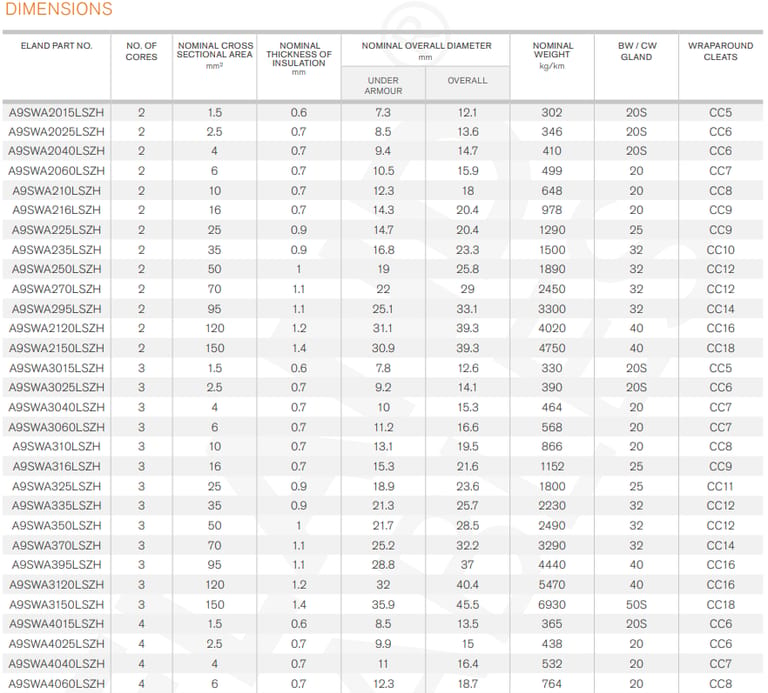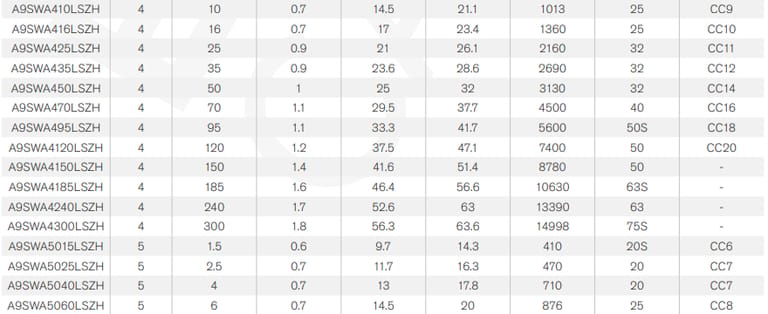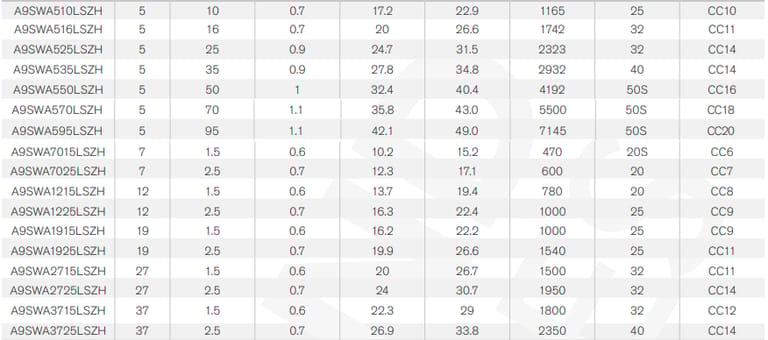Anhui Feichun Special Cable Co.,Ltd Li.wang@feichuncables.com

N2XRH Cu/XLPE/LSZH/SWA/LSZH 0.6/1kV Cable
N2XRH Cu/XLPE/LSZH/SWA/LSZH 0.6/1kV Cable: Ideal For Fire Safety, Underground Installations
Category | Details |
|---|---|
Application | European reference for a low voltage multi-core LSZH power cable with steel wire armour (SWA). Same construction as British Standard BS6724 cable. Power and auxiliary control cables for use in power networks, underground, outdoor and indoor applications, and for use in cable ducting. For installation where fire, smoke emission, and toxic fumes create a potential threat to life and equipment. |
Characteristics | |
Voltage Rating Uo/U | 0.6/1kV |
Temperature Rating | Fixed: -20°C to +90°C |
Minimum Bending Radius | 1.5mm² to 16mm² - Fixed: 6 x overall diameter 25mm² and above - Fixed: 8 x overall diameter |
Construction | |
Conductor | Class 2 stranded copper conductor |
Insulation | XLPE (Cross-Linked Polyethylene) |
Bedding | LSZH (Low Smoke Zero Halogen) |
Armour | SWA (Steel Wire Armour) |
Sheath | LSZH (Low Smoke Zero Halogen) |
Core Identification | |
2 Core | Brown, Blue |
3 Core | Brown, Black, Grey |
4 Core | Brown, Blue, Black, Grey |
5 Core | Green/Yellow, Brown, Blue, Black, Grey |
Alternative Core Identification | White cores with Black numbers |
Sheath Colour | Black |
Standards | BS 6724, IEC/EN 60228, EN 50267-2-1, IEC/EN 60502-1 Flame Retardant according to IEC/EN 60332-1-2, IEC/EN 60332-3-24 Cat C Low Smoke Zero Halogen according to IEC/EN 60754-1/2, IEC/EN 61034-1/2 |
ELECTRICAL CHARACTERISTICS XLPE/PVC/SWA/PVC
Nominal Cross Sectional Area (mm²) | Reference Method C (Clipped Direct) (Amps) | Reference Method E (In Free Air or Perforated Tray) (Amps) | Reference Method D (Direct in Ground or Ducting) (Amps) | |||
|---|---|---|---|---|---|---|
1 Two Core Cable (Single-Phase AC or DC) | 1 Three or Four Core Cable (Three-Phase AC) | 1 Two Core Cable (Single-Phase AC or DC) | 1 Three or Four Core Cable (Three-Phase AC) | 1 Two Core Cable (Single-Phase AC or DC) | 1 Three or Four Core Cable (Three-Phase AC) | |
1.5 | 27 | 23 | 29 | 25 | 25 | 21 |
2.5 | 36 | 31 | 39 | 33 | 33 | 28 |
4 | 49 | 42 | 52 | 44 | 43 | 36 |
6 | 62 | 53 | 66 | 56 | 53 | 44 |
10 | 85 | 73 | 90 | 78 | 71 | 58 |
16 | 110 | 94 | 115 | 99 | 91 | 75 |
25 | 146 | 124 | 152 | 131 | 116 | 96 |
35 | 180 | 154 | 188 | 162 | 139 | 115 |
50 | 219 | 187 | 228 | 197 | 164 | 135 |
70 | 279 | 238 | 291 | 251 | 203 | 167 |
95 | 338 | 289 | 354 | 304 | 239 | 197 |
120 | 392 | 335 | 410 | 353 | 271 | 223 |
150 | 451 | 386 | 472 | 406 | 306 | 251 |
185 | 515 | 441 | 539 | 463 | 343 | 281 |
240 | 607 | 520 | 636 | 546 | 395 | 324 |
300 | 698 | 599 | 732 | 628 | 446 | 365 |
400 | 787 | 673 | 847 | 728 | - | - |
Voltage Drop
Nominal Cross Sectional Area (mm²) | Two Core Cable DC (mV/A/m) | Two Core Cable Single-Phase AC | Three or Four Core Cable Three-Phase AC | ||||
|---|---|---|---|---|---|---|---|
r (mV/A/m) | x (mV/A/m) | z (mV/A/m) | r (mV/A/m) | x (mV/A/m) | z (mV/A/m) | ||
1.5 | 31 | 31 | - | - | 27 | - | - |
2.5 | 19 | 19 | - | - | 16 | - | - |
4 | 12 | 12 | - | - | 10 | - | - |
6 | 7.9 | 7.9 | - | - | 6.8 | - | - |
10 | 4.7 | 4.7 | - | - | 4 | - | - |
16 | 2.9 | 2.9 | - | - | 2.5 | - | - |
25 | - | 1.85 | 0.160 | 1.900 | 1.600 | 0.140 | 1.650 |
35 | - | 1.35 | 0.155 | 1.350 | 1.150 | 0.135 | 1.150 |
50 | - | 0.99 | 0.155 | 1.000 | 0.860 | 0.135 | 0.870 |
70 | - | 0.67 | 0.150 | 0.690 | 0.590 | 0.130 | 0.600 |
95 | - | 0.50 | 0.150 | 0.520 | 0.430 | 0.130 | 0.450 |
120 | - | 0.40 | 0.145 | 0.420 | 0.340 | 0.130 | 0.370 |
150 | - | 0.32 | 0.145 | 0.350 | 0.280 | 0.125 | 0.300 |
185 | - | 0.26 | 0.145 | 0.290 | 0.220 | 0.125 | 0.260 |
240 | - | 0.20 | 0.140 | 0.240 | 0.175 | 0.125 | 0.210 |
300 | - | 0.16 | 0.140 | 0.210 | 0.140 | 0.120 | 0.185 |
400 | - | 0.13 | 0.140 | 0.190 | 0.115 | 0.120 | 0.165 |



Introduction: The Unsung Hero of Electrical Infrastructure
In an era where reliable electricity is the backbone of modern life, cables like the N2XRH Cu/XLPE/LSZH/SWA/LSZH 0.6/1kV are quietly transforming how we power our world. This low-voltage power cable, often referred to simply as N2XRH, combines copper conductors with advanced materials to deliver safe, efficient energy transmission. Designed for environments where fire risks and mechanical stresses are high, it's a European-standard equivalent to the British BS6724 cable, emphasizing low smoke zero halogen (LSZH) properties to minimize hazards during fires.
As global demands for sustainable and resilient infrastructure grow, the N2XRH cable stands out for its role in power networks, underground cabling, and auxiliary control systems. In South Africa, where energy crises, cable theft, and fire safety concerns dominate headlines, this cable addresses pressing issues. With the country's renewable energy sector booming—aiming for 20GW of new capacity by 2030—this technology is pivotal.
Usage Scenarios:
The N2XRH cable's design targets scenarios demanding reliability amid hazards. It's ideal for power distribution in networks, underground burials, outdoor exposures, indoor wiring, and ducting. In fire-prone areas—like tunnels, hospitals, or high-rises—LSZH properties prevent toxic fumes, saving lives. SWA armour protects against physical damage in industrial sites, mines, or construction zones.
In renewable energy, it's used for connecting solar panels, wind turbines, or battery storage to grids, handling variable loads efficiently. For auxiliary control, it powers signaling in railways or automation in factories. South Africa's context amplifies its value: amid load-shedding, it supports micro-grids; in mining, it withstands harsh conditions; and in urban developments, it complies with fire codes.
In-Depth Analysis: Strengths, Limitations, and Innovations
Analyzing the N2XRH reveals why it's a game-changer. XLPE insulation's dielectric strength reduces partial discharges, extending lifespan to 40+ years. LSZH minimizes acid gas emissions (<0.5% per IEC 60754-1), crucial in confined spaces. SWA enhances tensile strength, with glands like BW/CW ensuring secure terminations.
Compared to PVC cables, N2XRH offers superior fire performance but at higher cost—up to 20% more due to materials. However, lifecycle savings from reduced maintenance and downtime justify it. Voltage drop calculations, incorporating r, x, and z, aid precise system design; for instance, ignoring inductance below 16mm² simplifies planning.
Innovations include eco-friendly variants with recycled copper, aligning with sustainability goals. In South Africa, local manufacturers like Aberdare Cables adapt it for SANS standards, boosting economy. Limitations? It's not submersible without extras, and installation requires skilled labor to avoid armour damage.
Electrically, capacity derates in bundles or high ambients, per IEE Wiring Regulations (BS7671). For 90°C operation, connected equipment must match, per Regulation 512.1.2. Overall, it's a balanced solution for safety-conscious, high-demand setups.
Frequently Asked Questions: Demystifying the N2XRH Cable
What makes LSZH better than PVC? LSZH emits less smoke and no halogens, reducing inhalation risks in fires—vital for public spaces.
Is it suitable for outdoor use? Yes, SWA and UV-resistant sheath protect against weather, but direct burial needs depth per regulations.
How does it compare to aluminum cables like NA2XRH? Copper (N2XRH) offers lower resistance for high-current needs, though aluminum is lighter and cheaper for long runs.
Can it handle South Africa's voltage fluctuations? Absolutely, with 0.6/1kV rating and XLPE stability, it's ideal for unstable grids.
What's the installation cost? Varies; for 100m of 2-core 10mm², expect R5,000-R10,000 including glands, but savings from durability offset.
Are there eco concerns? LSZH is halogen-free, and copper is recyclable, supporting green standards.
Conclusion: A Cable for Tomorrow's Challenges
The N2XRH Cu/XLPE/LSZH/SWA/LSZH 0.6/1kV cable exemplifies how materials science meets real-world needs, offering fire safety, mechanical toughness, and electrical efficiency. In South Africa, it's not just wiring—it's a tool against theft, fires, and energy woes, powering renewables and infrastructure. As trends evolve, with markets growing 8% annually (Mordor Intelligence), embracing such innovations ensures a safer, sustainable future. Whether you're an engineer or curious reader, understanding this cable highlights the invisible threads binding our powered world.

Email Address: Li.wang@feichuncables.com
© 2025. All rights reserved.


One-click to Quickly Contact
Products
Offshore & Marine Cable
XLPE Cable
Contact
Company
Location:
Building A Private Science and Technology Park, Hefei Economic and Technological Development Zone, Anhui Province, China
